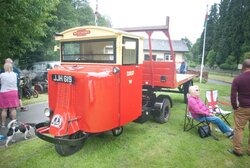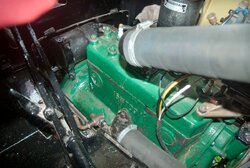The thing is, when I was repairing these things they were still being used, the county council I worked for tended to hang on to old gear, and some of it was very clever.
Wish I had pictures, the overloader was one, it was used to load wagons with salt, screw, buckets, and conveyor reversed tractor into salt pile and it loaded the gritter in front of it, over the top of the tractor.
But to see old stuff restored often better in the small events, at the local Heritage railway often we have a small event, and being small one can chat to the people who have done the work, this

is an example, they seemed such a good idea, they could get the trailer into the same space as a horse and cart, and had an automatic coupling no winding up the handle, so big question was why did they stop being used?
It seems due to new laws which required brakes on all wheels, the front wheel was not braked. Most were scrapped, and then people restored them, but because no longer have original log book, they can't be taken on the public road, so have to be moved on low loaders, so rarely seen.
The engine was very small

so maximum speed rather low, around 20 MPH I think, but in the days where branch lines went everywhere these were ample to take goods from rail head to final destination.
It seems laws have caused so much change, but I can't remember a single bike with only one wheel braked.
Villiers engines were really well made, but then came the Briggs and Stratton engine, designed to be throw away, aluminium bores, and aluminium bearings by time one bit had worn out, rest was also worn out, so when you stripped one everything needed changing. And they were so cheap you could not repair one for less than a new engine cost.
We have had the same with bikes of course, my mountain bike was bought for me by my late mother, so I have kept it, but to repair it when things go wrong costs more than whole bike cost, so although when a wheel went on the bike my son gave me I bought a new one at around £60 when it goes on a £75 bike it gets silly.



 ) but it won't budge. Time to improvise some kind of puller.
) but it won't budge. Time to improvise some kind of puller.


